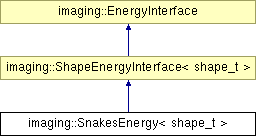imaging::SnakesEnergy< shape_t > Class Template Reference
[Segmentation Module]
Snakes energy for arbitrary shape classes.
More...
#include <SnakesEnergy.hpp>

Public Member Functions | |
| template<class const_accessort_t> | |
| SnakesEnergy (const const_accessort_t &edge_map, const shape_t &initial_shape, float_t beta, std::size_t n_integration_points) | |
| ublas::vector< float_t > & | current_argument () |
| const shape_t & | current_shape () const |
| float_t | current_energy () const |
| std::size_t | dimension () const |
| void | set_argument () |
Detailed Description
template<class shape_t>
class imaging::SnakesEnergy< shape_t >
Snakes energy for arbitrary shape classes.
This class template implements the Snakes functional for shapes of the type shape_t. The template parameter shape_t must implement ShapeInterface.
The Snakes functional reads as follows:
![\[ I_\beta^{\textrm{Snakes}}(\gamma) = - \int_\gamma u(\gamma) d \tau + \beta \textrm{Length}(\gamma)\,. \]](form_84.png)
Usually  is chosen as
is chosen as
![\[ u = | \nabla f |\,, \]](form_85.png)
for an image  . Thus,
. Thus,  contains the edges of
contains the edges of  .
.
Upon construction a SnakesEnergy object is initialized to an Image  and an initial shape
and an initial shape  .
.
Then, the SnakesEnergy objects maps a vector  to the corresponding energy as follows:
to the corresponding energy as follows:
![\[ v \mapsto I_\beta^{\textrm{Snakes}}\big(\textrm{Exp}_\mu(v)\big)\,. \]](form_86.png)
Constructor & Destructor Documentation
| imaging::SnakesEnergy< shape_t >::SnakesEnergy | ( | const const_accessort_t & | edge_map, | |
| const shape_t & | initial_shape, | |||
| float_t | beta, | |||
| std::size_t | n_integration_points | |||
| ) | [inline] |
Constructs a SnakesEnergy object. The first three arguments are explained in the class description. The parameter n_integration_points refers to the number of integration points when integrating along the shape boundary.
Member Function Documentation
| ublas::vector<float_t>& imaging::SnakesEnergy< shape_t >::current_argument | ( | ) | [inline, virtual] |
Access the current argument of the energy. In general the user should not resize the current argument!
Implements imaging::EnergyInterface.
| const shape_t& imaging::SnakesEnergy< shape_t >::current_shape | ( | ) | const [inline, virtual] |
Returns the current shape. This function should not actually compute the current shape but return the cached result of the last call to set_argument()!
Implements imaging::ShapeEnergyInterface< shape_t >.
| float_t imaging::SnakesEnergy< shape_t >::current_energy | ( | ) | const [inline, virtual] |
Returns the current energy. This function should not actually compute the current energy but return the cached result of the last call to set_argument()!
Implements imaging::EnergyInterface.
| std::size_t imaging::SnakesEnergy< shape_t >::dimension | ( | ) | const [inline, virtual] |
Returns the dimension the class expects as input data. The function current_argument() will return a vector of this dimension and the user should not change the size of this vector!
Implements imaging::EnergyInterface.
| void imaging::SnakesEnergy< shape_t >::set_argument | ( | ) | [inline, virtual] |
Compute the energy value corresponding to the current argument. This is where the main work of the energy evaluation should be done.
Implements imaging::EnergyInterface.
The documentation for this class was generated from the following file:
- imaging2/segmentation/SnakesEnergy.hpp
 1.5.5
1.5.5